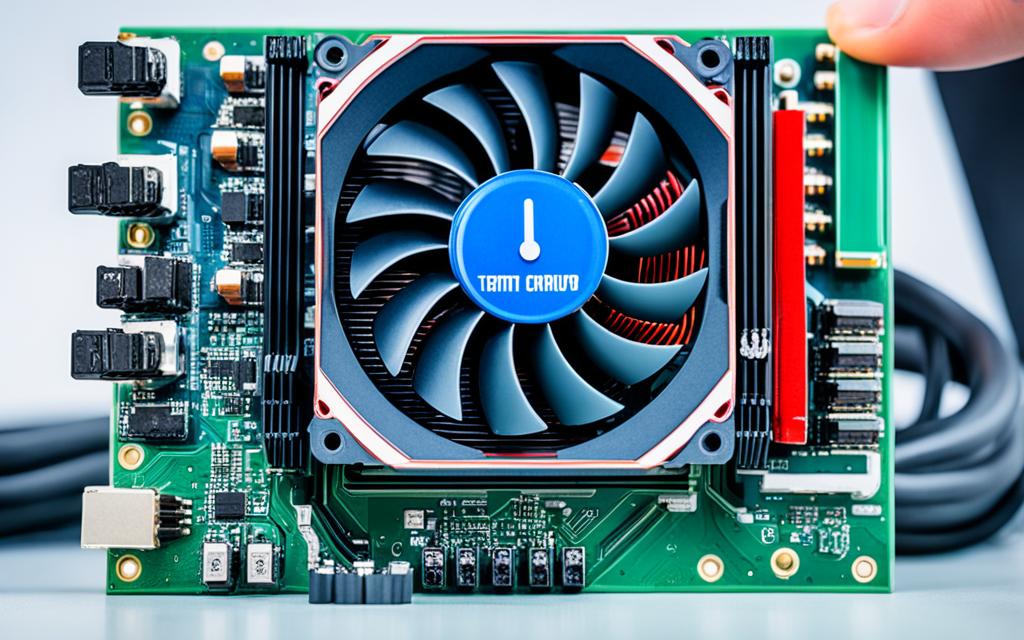Table of Contents
The health of your CPU relates closely to its operating temperature. This is crucial for keeping your CPU working well. Knowing the right temperature prevents overheating. It also helps your CPU last longer. By checking the temperature, you can spot problems early. This stops serious damage caused by too much heat.
Under normal use, CPUs work well between 40-60 degrees Celsius. Intense software might increase temperatures to around 80 degrees Celsius1.Regular checks of the temperature are important. Especially when your computer is working hard, you want to avoid overheating.
We will look at the best temperatures for your CPU. Also, how to keep an eye on these temperatures and keep your CPU cool. Good for gamers or everyday users, watching CPU temperatures makes your computer run better.
Key Takeaways
- CPU temperatures should ideally be maintained between 30°C and 60°C for optimal performance.
- Consistent temperatures above 80°C can hinder CPU performance or lead to hardware damage.
- Monitoring CPU temperature is essential, especially during intensive tasks like gaming or streaming.
- There are multiple tools, both built-in and third-party, available for accurate temperature tracking.
- Regular maintenance, including cleaning and effective cooling solutions, can prevent overheating.
Understanding CPU Temperature and Its Importance
Knowing about CPU temperature is key to keeping your computer running smoothly. The CPU is crucial for processing data fast and well. It’s temperature tells us how well the CPU is doing. Making sure the CPU doesn’t get too hot helps prevent serious damage.
What Does CPU Temperature Indicate?
The CPU temperature shows how well your processor is working. A good idle temperature is below 50 degrees Celsius. When busy, it should stay under 80 degrees Celsius2. Watching these temperatures helps stop the CPU from working less efficiently. If it goes over 95 degrees Celsius, your CPU could get damaged or work poorly2.
The Role of CPU in Computer Performance
The CPU is vital for running programs and affects how fast and smoothly your computer works. If it gets too hot, it won’t work as well. This can even cause permanent damage3. Even though some CPUs like the AMD Ryzen 5000 series can go up to 95 degrees Celsius2, keeping them cool is important for their health and performance.
| CPU Model | Max Operating Temperature | Cooling Type |
|---|---|---|
| AMD Ryzen 5000 Series | Up to 95°C | Stock Air Cooler |
| AMD Ryzen 7000 Series | Up to 95°C | Water Cooler |
| Intel Core i9 (12th to 14th Gen) | Up to 100°C | N/A |
What Should a CPU Temp Be for Optimal Performance?
Knowing the optimal CPU temp is key to keep a top-functioning system. It is needed for today’s demanding tasks. Checking the temperature often stops thermal throttling. This ensures the CPU works efficiently and lasts longer.
Normal Operating Temperatures for Different Workloads
Normal CPU temps depend on the activity. Generally, CPUs should be between 30°C and 40°C (86°F to 104°F) when idle. When busy, like during gaming or using big applications, they may reach 60°C to 70°C (140°F to 158°F). They can go up to 80°C (176°F)4 safely.
Watching the CPU temperature is critical with heavy use. Overheating past 80°C may harm the CPU5.
A useful table of expected temperatures for various tasks is shown below:
| Load Type | Idle Temperature (°C) | Load Temperature (°C) |
|---|---|---|
| Idle | 30 – 40 | — |
| Normal Workload | — | 60 – 70 |
| Heavy Load (e.g., Gaming) | — | 75 – 80 |
| Maximum Safe Temperature | — | 80 |
Safe Temperature Ranges for Modern Processors
Knowing the safe CPU temperature ranges for various models is essential. Most CPUs run safely between 40°C and 80°C (104°F and 176°F) under normal load. With heavy load, they can handle 60°C to 90°C (140°F and 194°F)4.
Staying within these ranges helps durability and avoids performance problems. It also boosts the CPU’s lifespan and efficiency6.
How to Check Your CPU Temperature Easily
Keeping your CPU temperature just right is key for a fast, healthy computer. There are many ways to keep an eye on it. Learning to track your CPU’s heat helps you stop overheating and damage before it starts.
Utilising BIOS/UEFI for Temperature Monitoring
One easy method is checking through BIOS. Simply reboot and press a special key to enter BIOS or UEFI settings. You’ll see the temperature there. It’s great for a quick check but not for watching the temperature constantly. For specifics on how to do this, see your motherboard’s guide.
Third-Party Software Tools for Accurate Readings
For constant tracking, software is your best friend. Tools like Core Temp, HWMonitor, and CPU-Z give you detailed temperature and fan speed info. They work quietly while you do your thing, updating you in real time. This lets you catch and fix overheating early, keeping your CPU safe and efficient7.
Using Infrared Thermometers for Real-Time Measurement
Or, use an infrared thermometer for instant temperature checks. It’s fast and doesn’t need a system shutdown. Devices like the NF-HT650C and NF-521S make it easy to spot high temperatures while your PC runs. They’re great for checking your cooling system’s performance. These tools are perfect for keeping things cool8.
Reasons Why Your CPU Might Be Overheating
Knowing why your CPU gets too hot is key to keeping it working well. Many things can make your CPU overheat, which can slow it down or even damage it. Here are the main reasons your CPU might be too warm.
Dust Accumulation and Its Effects
Dust can block airflow, making your computer hotter. When dust stops fans from working right, your CPU can’t stay cool. To avoid this, clean your computer’s fans and vents often. If too much dust gathers, your system could get hotter than 176°F (80°C), which is bad for both its speed and health910.
Poor Cooling Solutions and Case Ventilation
If your cooling isn’t good enough, your CPU will heat up too much. Heatsinks and fans that don’t work well can’t take away enough heat. This can make CPUs too hot, especially when doing hard tasks, and they can heat up to between 158–176°F (70–80°C)9. Adding more fans or a better CPU cooler can make a big difference.
The Impact of Overclocking on CPU Temperature
Overclocking can make your CPU faster but also hotter. Using your CPU for tough tasks makes it produce more heat. This can push temperatures over the safe 80°C (176°F) limit if you’re not careful910. Monitoring your CPU’s heat and overclocking wisely keeps things running smoothly.
Effective Methods to Lower CPU Temperature
Getting your CPU temperature down is key for better performance. Many methods exist to improve your cooling efforts. Doing this helps your CPU work better for longer.
Improving Cooling Systems
Boosting your cooling systems is vital for reducing CPU heat. Opting for a superior CPU cooler or better case fans can make a big difference. For instance, liquid coolers with a 360mm radiator beat traditional air coolers11. Cleaning your PC often cuts down CPU heat effectively and affordably12.
Replacing old heat paste with new thermal paste aids in better heat transfer11. Moreover, adjusting fan speeds, especially to Performance mode, plays a big role in cooling12.
Room Temperature and Environmental Considerations
The temperature of your room influences CPU functioning. Using air conditioning helps by keeping the room cooler, which boosts the cooling process12. Removing the side panel of your PC can also drop the CPU temp slightly by improving airflow12.
Proper Maintenance and Regular Cleaning
Regular upkeep is crucial for your CPU’s performance. Lowering the CPU’s power consumption through undervolting or underclocking can reduce heat. However, this might impact its performance12. It’s also important to keep an eye on dust, as it can block airflow, needing frequent cleaning. By following these maintenance steps, you can keep your CPU cool, ensuring its durability and efficiency.
Conclusion
Keeping your CPU at the right temperature is crucial for top performance and long life. The best temperature range is usually between 61° C to 75° C. It’s important not to let it go over 85° C. Even though modern Intel CPUs can handle up to 100°C, they do better if not pushed past 99°C for too long1314.
Make sure to check your CPU’s temperature often. Look out for signs of too much heat, like dust build-up or poor cooling setups. You can solve these problems early on. A good cooler, such as the Cooler Master Hyper TX3, can make a big difference. It shows that spending a bit more on cooling pays off13.
Choosing the right overheating fixes is key to a better and more reliable PC. Improve airflow, use high-quality thermal paste, and pick the right software to watch over temperatures. Core Temp or SpeedFan are great for keeping an eye on things. They help your computer stay cool and run without any hitches15.
FAQ
What is the ideal CPU temperature for optimal performance?
The best CPU temperature is below 80°C. When not doing much, it should be between 30°C to 40°C. Under heavy use, it stays around 60°C to 70°C.
How can I check my CPU temperature?
Check your CPU’s temp through the BIOS/UEFI for a quick look. For ongoing checks, use software like Core Temp or HWInfo. An infrared thermometer can also measure surface temps well.
Why is my CPU overheating?
Overheating can be caused by dust build-up, poor cooling, or overclocking. Keeping your system clean and well-ventilated is key to avoiding these problems.
What can I do to lower my CPU temperature?
Improve cooling by cleaning dust off parts, using good thermal paste, or getting better coolers. Keep your room cool and do regular checks on your system.
What are the signs that my CPU is overheating?
Overheating signs include temps over 80°C, unstable system, slowdowns, sudden shut offs, or crashes during heavy use.
Which third-party software is best for monitoring CPU temperature?
Core Temp and HWInfo are top choices for checking your CPU’s temperature accurately and in real-time.
How does CPU temperature affect overall computer performance?
High CPU temps can lower performance by causing throttling. This makes your computer slow and less responsive. Keeping it cool is essential for it to run well.
Source Links
- https://community.spiceworks.com/t/what-is-a-normal-temperature-for-a-cpu-and-how-do-i-keep-it-low/948818 – What is a normal temperature for a CPU and how do I keep it low?
- https://www.tomshardware.com/how-to/how-to-check-cpu-temp-temperature – How to Check Your CPU Temperature
- https://www.lenovo.com/us/en/glossary/what-is-cpu-temperature/ – Cpu Temperature: What is CPU Temperature?
- https://www.linkedin.com/advice/3/what-normal-optimal-ranges-cpu-temperature-different – What are the normal and optimal ranges of CPU temperature for different types of processors?
- https://www.shiksha.com/online-courses/articles/all-about-cpu-temperature-range/ – CPU Temperature Range That Must Be Maintained – Shiksha Online
- https://www.merchmates.co.uk/blog/tech/good-idle-cpu-temp/ – What Is A Good Idle CPU Temp?
- https://softwarekeep.com/blogs/how-to/how-to-check-cpu-temp-in-windows-10-11 – How To Check Your CPU Temperature in Windows 10/11
- https://www.avg.com/en/signal/check-cpu-temperature – How to Check and Monitor CPU Temperature on Windows and Mac
- https://www.crucial.com/support/system-maintenance-cooling – How to cool down your PC or Laptop
- https://www.linkedin.com/advice/0/what-common-causes-symptoms-cpu-overheating-skills-computer-repair – What are the common causes and symptoms of CPU overheating?
- https://www.xda-developers.com/how-to-lower-cpu-temperature/ – How to lower your CPU’s temperature
- https://www.digitaltrends.com/computing/how-to-lower-cpu-temperatures/ – How to lower your PC’s CPU temperatures, from easy to expert | Digital Trends
- https://www.pugetsystems.com/labs/articles/impact-of-temperature-on-intel-cpu-performance-606/ – Impact of Temperature on Intel CPU Performance
- https://directmacro.com/blog/post/what-is-optimal-cpu-and-gpu-temp – What Is Optimal GPU Temp and CPU Temperature Range
- https://outbyte.com/blog/good-safe-cpu-temperature-check-optimize/ – Good and Safe CPU Temperature — How to Check and Optimize?








